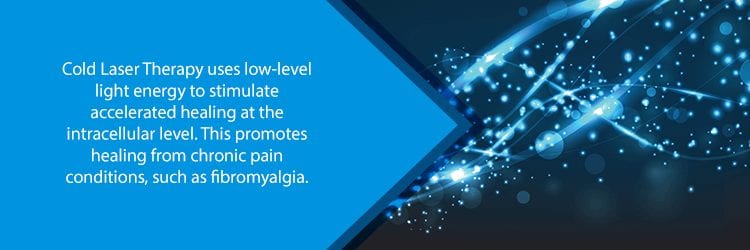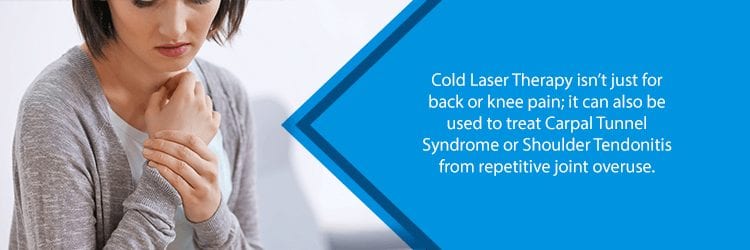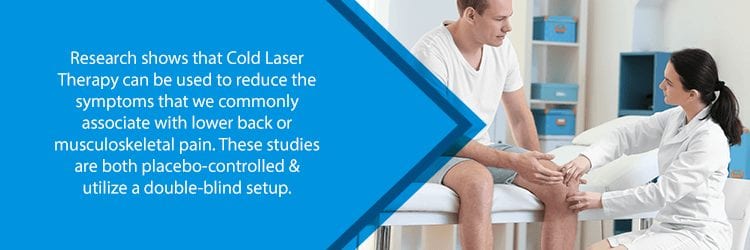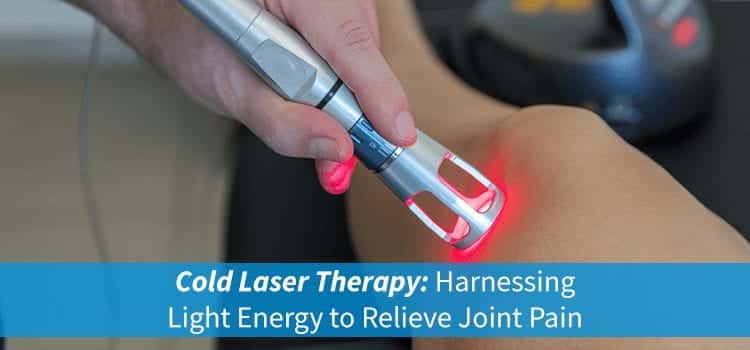Cold laser therapy (CLT), also known as photobiomodulation therapy or low-level laser therapy (LLLT), uses wavelengths of light to treat a variety of ailments. These wavelengths interact with the affected tissues in order to achieve accelerated healing. Doctors may use this treatment for patients who suffer from either chronic or acute conditions. The ultimate goal of Cold Laser Therapy is to alleviate symptoms, such as pain, swelling, and spasms. Through this symptom alleviation, many patients find a return to greater functionality in the target area.
CLT has actually been around for quite some time now. Initially, Albert Einstein discovered the theory of light amplification through stimulated emission of radiation (LASER) in the early 1900s. Fifty-one years later, Professor Andre Mester started using low-power lasers to treat his patients. This was the first notable use of such a treatment in the field of medicine.
The FDA categorizes medical lasers into three groups. The most powerful are class 4 surgical lasers, which doctors use to cut through tissue. This is the only “painful” type of medical laser. The next laser category is class 3B non-surgical lasers, which do not cause pain or burning sensations. This laser class, however, is able to reach deeper areas, which allows it to address problems with joints and deep tissues. Lastly, are class 3A lasers, which doctors use to heal minor injuries and conditions. This laser is the weakest of the three.

What Does Cold Laser Therapy (CLT) Treat?
CLT is versatile, as it works on all cell types (such as muscle, ligament, cartilage, nerves, and so on). Because of this fact, there are many conditions that exist where CLT is a viable treatment. Here is an overview of common conditions that CLT treats:
- Arthritis: At its most basic form, arthritis is the inflammation of one or more joints in the body. The problem may be a result of cartilage degeneration from everyday wear and tear, or it may be because of an autoimmune disease (such as rheumatoid arthritis). The condition exists in many forms. General arthritis symptoms include pain, stiffness, and swelling. Arthritis of the knee is the most common, as it is a load-bearing joint.
- Fibromyalgia Pain: A common, yet complex, chronic pain disorder that causes pain and tenderness throughout the body. Fibromyalgia is not very well understood, and symptoms vary in intensity from case to case. There are often mental health symptoms associated with this condition, such as depression and difficulty concentrating.
- Tendonitis: Tendonitis is the inflammation of the tendons–the cord-like glue that holds bones and muscles together. Most commonly, this injury is the result of minor, repetitive impacts in the same area over a period of time.
- Carpal Tunnel Syndrome: Carpal tunnel syndrome compresses the primary nerves in the hand as they pass through the wrist. Usually, this condition causes pain, numbness, and tingling in both the hand and arm. Most of the time, this condition worsens without treatment. Thankfully, CLT is known to give carpal tunnel relief.
CLT also treats more general conditions, such as chronic back pain and musculoskeletal pain. Additionally, some doctors use CLT for wound healing of minor sprains and injuries.

How Does Cold Laser Therapy (CLT) Work?
Cold laser devices are actually quite small–to the extent that most are often completely handheld. First, the doctor places the laser above the affected area for a period of time. Usually, this lasts about 30 seconds to a few minutes, depending on the nature of the condition.
While the laser is being held, it produces non-thermal light photons that pass through several layers of skin. These layers include the dermis, epidermis and underlying fat tissues. Generally speaking, most of these laser devices have the ability to pass through 2 to 5 centimeters of tissue.
Once the light energy has penetrated the skin layers and reaches the affected area, the light-sensitive cellular structures absorb the light. This process is very similar to plant photosynthesis, where plants absorb sunlight to produce energy. As you may expect, this is where the photobiomodulation moniker originated from.
After the cells absorb the light, a process begins in the cell that accelerates healing. Patients report alleviation on many different fronts, including pain, inflammation, edema, and faster recovery time.
Is Cold Laser Therapy (CLT) Effective?
The short answer is yes. The slightly longer answer is yes, but we do not exactly know the full extent of its effectiveness yet. For quite some time, doctors have been treating patients with CLT as a conservative option for pain management. Over the past 50 years, medical experts have conducted thousands of studies on the matter. The majority of these studies have shown that CLT is a proven method for pain relief. All of these studies use a scientific approach, with double-blinded, placebo-controlled variables as benchmarks.
The main component of CLT that is not really understood pretty much boils down to dosage and the number of treatments. This is likely due to the variety of different conditions that CLT treats, as well as individual biochemistry. That being said, there is conclusive evidence to support the fact that CLT alleviates both limiting and non-limiting conditions.

Cold Laser Therapy (CLT) Advantages
The biggest advantage of CLT is that it is not an invasive procedure. This means that CLT does not use any surgical incisions to provide treatment to the patient. Because of this, one of the main advantages of CLT is its fast recovery time. There is no chance of any damage occurring to surrounding or affected tissues. Additionally, CLT is a conservative alternative to more risk-inherent treatments, such as pain medication. Some pain medications are highly addictive, which may lead to serious health problems if they are not taken as directed. This is hard for some, because when we are in pain we naturally seek ways to relieve it. As a result, this often translates to addiction problems.
CLT does not have any specific disadvantages innate to the procedure itself. The only potential disadvantages are the ones associated with any form of medical treatment. There is always a chance that the patient may not achieve symptom relief with the first treatment. It may or may not take a series of treatments depending on the state of the patient’s condition. This, however, is true for almost any form of medical treatment and is not unique to CLT.
Do I Qualify For Cold Laser Therapy (CLT)?
As with most medical treatments, the answer to this question depends on your case and your condition. Doctors do not recommend the treatment for patients with cancerous lesions, or carcinoma. Additionally, pregnant women should not undergo CLT. This, however, is only a precaution, as it is not known whether or not CLT affects unborn children.
Talk with your doctor to see if CLT is right for your individual case. He or she will need to obtain a variety of personal facts, such as pre-existing medical conditions and your family medical history. Be sure to communicate any questions with your doctor, as it will help you understand your situation to the fullest extent.
Do you have chronic pain in the joints, or for that matter, any part of your body? If so, you may qualify for CLT. Please contact NJSO at (855) 586-2615 for additional information. Our orthopedic doctors are leading experts in minimally invasive and conservative treatments. We ensure that you will get the right treatment to serve your specific needs.

